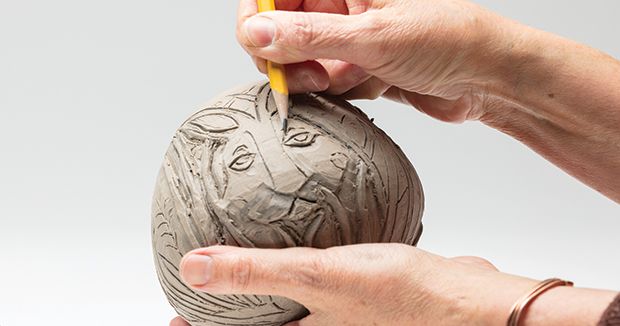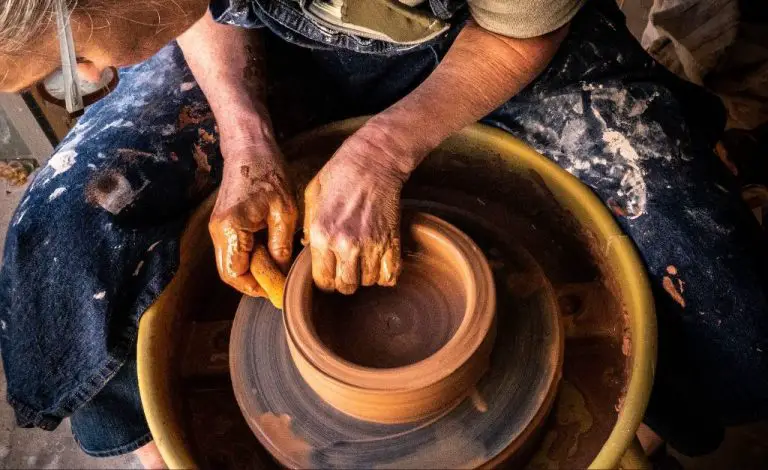What Makes Clay Black?
Clay is a natural material composed primarily of fine-grained minerals like kaolinite, illite, and montmorillonite. Clays develop plasticity when mixed with water, allowing them to be shaped or molded. While clay deposits are found worldwide and utilized for pottery and ceramics, clays come in a diverse range of colors from white and red to brown and black. This article will explore the composition and firing process that gives clay its black color.
Composition of Clay
Clay is made up of fine-grained minerals like silica, alumina, water, and iron oxides. The exact composition varies depending on the type of clay. Silica, in the form of quartz, makes up about 40-80% of clay by weight. Alumina, from materials like feldspar, accounts for 10-40%. Water interacts with the silica and alumina to influence the clay’s plasticity. Iron oxides, while only making up 1-15% of clay, have an important effect on its color.
The small particle size of clay minerals, less than 0.002 mm in diameter, is what gives clay its unique properties. This fine grain structure allows the minerals to develop plasticity when mixed with water, making clay easy to mold into different shapes. The types and amounts of minerals present affect the clay’s color, texture, and firing qualities.
Iron Oxides in Clay
Iron oxides like magnetite are one of the primary causes of black, brown, yellow, and orange colors in clay. These iron oxides occur naturally in certain clays depending on the mineral content of the clay deposits. Iron oxide molecules have a very strong color and only tiny amounts are needed to cause a drastic color change in clay.
The most common iron oxides found in clay are hematite and magnetite. Hematite lends a reddish color while magnetite creates black or dark brown tones. As the iron oxide content increases in the clay, the color becomes a deeper red or black. Firing the raw clay converts more of the iron to hematite, intensifying the redness. When used in combination with other minerals like manganese, iron oxides can also produce tan, orange, terra cotta, and brick colors.
Clays harvested from certain locations are naturally high in iron content. These native iron-rich clays produce dark colors without any additives or stains. However, low iron clays can also be stained black or brown using additional iron oxide pigments. By controlling the iron oxide content, clay artists can achieve a wide palette of natural earth tones in their finished ceramic pieces.
Firing Process
The firing process is critical for transforming iron oxides in clay from their original red or yellow colors into black. When clay is fired in a kiln, the increasing heat causes chemical reactions to occur.
Most clays are fired between 2,200°F and 2,400°F. At these high temperatures, the iron oxide molecules give off their oxygen atoms in a process called reduction. This changes the molecular structure of the iron and causes it to turn black in color.
The longer the clay is fired and the higher the temperature, the more oxygen is lost and the blacker the clay becomes. Gas kilns that limit oxygen exposure promote a more complete reduction.
In some cases, clays or clay bodies that already contain a significant amount of iron may turn black at lower firing temperatures around 1,800°F. However, firing to higher temperatures ensures a deeper, truer black.
The firing process unlocks the black color that was latent in the clay all along. Proper heat treatment in a kiln encourages the chemical changes needed for iron oxides to express their blackness.
Native Black Clays
Some clays have naturally occurring iron and other mineral deposits that result in black or dark gray coloring. These native black clays require no additives or special processing to achieve their dark tones. One of the most well-known examples is New Zealand’s metanocite, an extremely fine-grained clay that exhibits a deep black color in its raw form.
Metanocite is formed from the chemical weathering of volcanic ash deposits. The high levels of iron oxides and titanium dioxide in the ash deposits transfer into the clay composition as it breaks down over time. In addition to the iron content, the incredibly small particle size of metanocite contributes to its dark color. The tiny platelet structure reflects very little light, creating the appearance of a black color.
Other naturally occurring black clays include Attapulgite found in the Southeastern United States and Picasso marble clay indigenous to Idaho. While not as deep black as metanocite, these clays still exhibit dark grayish hues without any manipulation or additives. Their color comes from the natural iron oxides present in the surrounding soil where the clays formed.
Native black clays are prized for their natural dark tones. Artists and potters seek them out to create dark surfaces and rich black glazes without having to artificially introduce colorants. The native iron content also produces interesting speckling, streaking, and shading effects during firing that can enhance the visual depth and interest of finished ceramic pieces.
Staining Clay Black
One method for turning clay black is by staining it with metal oxides. The most common stains used are manganese dioxide and iron oxide. These stains work by chemically reacting with the clay body during firing to produce black metallic compounds.
Manganese dioxide stain is extremely powerful and only small amounts are needed to achieve a deep black color. It reacts during firing to form black manganese oxide. Iron oxide stains, such as red iron oxide, react to form black iron oxide compounds like magnetite.
Both manganese dioxide and iron oxide stains must be mixed into the clay body prior to firing. The stains permeate the clay and bond with it during the heat of the kiln. Firing temperature affects the final color, with higher temperatures generally producing a darker black finish.
Staining is an easy way to reliably produce black clay bodies. It allows the ceramic artist to turn any natural clay color into black. The intensity of the black color can be controlled by adjusting the amount of stain used.
Colorants
One of the most common ways to intentionally make clay black is by adding black mineral pigments or carbon additives to the clay body. These colorants are mixed into the clay before firing to produce a deep, saturated black color. Some common options for blackening clay include:
Manganese dioxide – A mineral pigment that fires to black. It’s sometimes called bisto or pyrolusite. Manganese dioxide must be added in amounts up to 10% of the clay body to achieve a true black.
Iron oxide – Natural sources of iron oxide like red iron oxide or black iron oxide can produce black speckles and accents when added sparingly to clay. Larger percentages will create more of a dark brown or chocolate hue.
Chromium oxide – Also called chrome oxide green, this pigment fires to a very deep black/green when used in clay bodies. Only small amounts are needed.
Carbon or charcoal – Powdered carbon sources like charcoal or activated carbon can be used to blacken clay as well. Up to 10% additions are typical for a black clay body.
Coal or oxides – Certain coal or oxide mineral additions will impart black speckling and accents within the fired clay. These include oxides like cobalt, copper, and nickel.
Clay Body Formulas
There are several clay body recipes and methods that potters use to produce black clays. Here are some examples:
High Iron Clay Bodies: A simple way to create black clay is to start with a naturally high iron clay. Some common clays known for their iron content include Black Mountain Clay and Old Hickory Clay. These clays will fire to a dark black or brown color without the need to add additional colorants.
Adding Iron Oxide: Iron oxide is commonly added to white or light colored clays in amounts ranging from 5-15% to achieve a black finish. Red iron oxide or black iron oxide can be used. The more iron oxide added, the darker the fired color will be.
Slip Glazing: Making a black slip glaze from clay, water, and metal oxides like red iron oxide can create a smooth black surface when used to coat clay forms. Multiple layers are often applied to increase darkness.
Staining: Stain recipes with colorants like copper carbonate, cobalt carbonate, manganese dioxide, or chromium oxide can be applied to bisque ware and will turn black when fired.
Smoke Firing: Firing clay in a reduction atmosphere or allowing smoke to come in contact with the ware during firing can achieve a black color effect. This works best with high iron clays.
Testing small samples is recommended when formulating a clay body for a desired black color result. Factors like clay composition, firing temperature and atmosphere affect the final color.
Artistic Uses
Black clay offers some unique properties for artists working in ceramics and sculpture. The dark color provides high contrast when used with lighter clays, allowing artists to create dramatic designs. Black clay is also valued for its smooth, velvety appearance when fired.
In pottery, black clay is often used by itself or blended with other clays to create a dark background color. Decorative techniques like sgraffito can then be used to scratch intricate designs through the black surface to reveal the light clay underneath. Using black clay for accent colors in handles, rims or feet of vessels is also common.
Sculptors may choose black clay for its somber and elegant look. The color evokes weight and mass, giving sculptural forms a grounded, earthy feeling. When polished, black clay can take on an alluring luster. Sculptors also appreciate black clay’s stability during firing.
For tilework and mosaic art, black clay provides definition between pieces and adds depth to patterns. Black glazes over clay create a glossy background that makes other colors stand out more. And for functional pieces like plates and platters, the striking look of black clay offers an upscale, sophisticated style.
Conclusion
In summary, there are a few key factors that influence the black coloration of clay. Iron oxide content is perhaps the most significant, as iron compounds like hematite and magnetite impart deep black, brown, and red hues when fired under oxidizing conditions. The presence of organic material can also darken clay bodies to grey or black colors through chemical reactions at high temperatures. Some clays have naturally high iron and carbon contents that make them black when fired, like many clays found in central and southern US states.
Clay can also be stained or painted with colorants like manganese dioxide or cobalt carbonate to produce jet black finishes after firing. When creating clay artworks or pottery, understanding how to control the atmosphere and temperature in the kiln enables artists to manipulate the colors and textures of the finished piece.
Overall, the firing process and chemical composition of the raw clay are the key factors determining the final black color. By learning how iron oxides, native carbon, and supplementary colorants interact with clay at high heat, ceramic artists can intentionally create beautiful black clay masterpieces.





